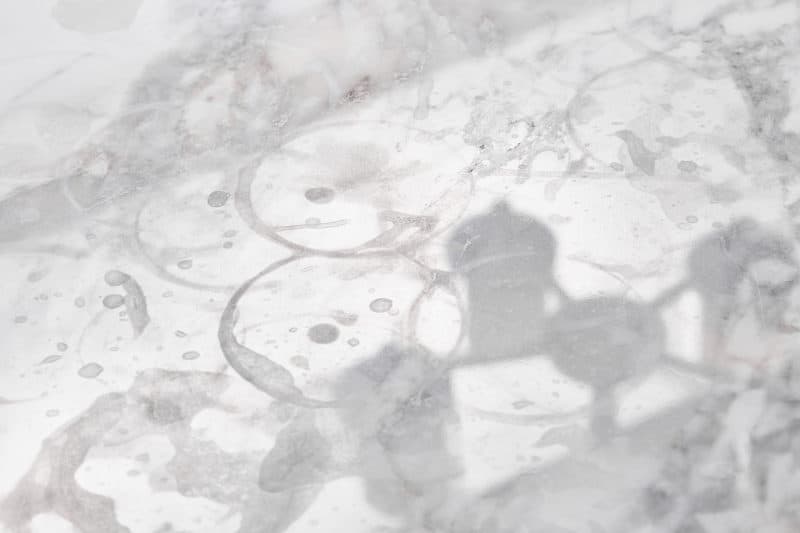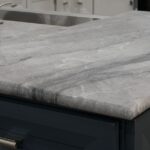We all know the deal when it comes to natural stones: if it’s porous, it needs regular cleaning – and even a sealer every once in a while, if you’d like to preserve its lifespan to the fullest. That said, marble countertops in particular are quite delicate, being prone to scratches, etches, cracks, and stains, with the latter causing a lot of trouble for unsuspecting homeowners. What about you – do you know how to remove water stains from marble countertops?
Well, if you don’t, no need to worry. In today’s article, we’ll guide you through the recommended ways of cleaning marble surfaces on a daily basis, highlighting the do’s and don’ts of light maintenance. Keep reading to have your countertops shining again!
To check out our complete article on marble countertops, click here.
What are water stains and how do they form?
Before anything, you should know that marble is a porous natural stone composed mainly of calcium carbonate, which reacts with water and acidic substances.
Water stains are the result of a mineral process. You see, when water comes into contact with marble, it can carry minerals and deposits from the surrounding environment; as the water evaporates, these minerals are left behind, causing unsightly discolorations on the surface if not wiped off.

In the long run, these water stains are often characterized by their lighter or darker appearance than the marble stone that surrounds them. They might feel slightly rough to the touch due to the mineral deposits that have bonded with the stone’s surface, so it’s very distinctive from traditional scratches by sharp objects and corrosion from etches (more on this later).
How to remove water stains from marble countertops: step by step
There are several ways to handle this task – and truly, homemade solutions should be your best bet, given how efficient most of them are. Below, we’ve listed the main contenders for removing water stains from marble stones, but make sure to call for professional help if you show insecurity or, worse yet, if no results are achieved after applying them.
With soap and water
- Mix a small amount of pH-neutral dish soap with warm water.
- Dampen a soft cloth with the solution and gently wipe the stained area.
- Rinse the cloth thoroughly and wipe the area again to remove any soap residue.
- Dry the marble surface with a clean, dry cloth.
With baking soda poultice

- Create a paste by mixing baking soda with water until a thick consistency is achieved.
- Apply the paste over the water-stained area, forming a layer about ¼ inch thick.
- Cover the poultice with plastic wrap and leave it to sit for 24 to 48 hours.
- Remove the poultice and rinse the area with water. Dry with a clean cloth.
With hydrogen peroxide
- Mix a few drops of hydrogen peroxide with a tablespoon of ammonia (for deep stains) or baking soda (for light stains) to form a paste.
- Apply the paste to the stain and cover with plastic wrap for 24 hours.
- Rinse and wipe the area clean, then dry with a cloth.
With commercial marble cleaner
- Choose a commercial marble cleaner that is specifically designed to remove stains.
- Follow the manufacturer’s instructions for application and removal.
How to prevent water stains on marble
Better than solving the problem is not having the problem in the first place, right? Well, fortunately, even in our busy routines, we can undertake some simple measures to avoid this situation altogether.
Do you want to know how? Wipe down marble surfaces regularly with a damp microfiber cloth to remove water and debris every two days or so – you’ll see the difference right away. Always use pH-neutral dish soap and warm water for cleaning, avoiding abrasive materials such as white vinegar, lemon juice, chlorine bleach, and ammonia.
Here’s a tip: It’s best to stay far away from steel wools and abrasive pads, as they can scratch the marble surface even further. However, many experts suggest these products as alternative methods to deeply brush all the build-up that simply doesn’t give away. The key is to be gentle – because metal can act like a razor if you’re not careful.
Other deterrent activities include:
- Use cutting boards to keep acidic liquid like lemon or tomato juice off the counter;
- Keep paper towels on hand to quickly soak standing water and other liquids;
- Use supply coasters for sweating drinks;
- Regularly wash your marble countertops with mild dish soap and water;
- Wipe the marble down with a marble counter sealer spray once a month.

Why sealing is so important
Of course, sealing your marble countertops is essential to prevent water and other liquids from penetrating the porous surface. A quality marble sealer provides a protective barrier, reducing the likelihood of water stains and other types of damage. Be sure to follow the manufacturer’s guidelines for sealing frequency!
Learn all about marble sealing in this complete guide.
Stain vs etches
While water stains can be a nuisance, there is another phenomenon that can affect marble countertops: etching. Understanding the difference between stains and etches is crucial – as etches are more complex and challenging to address, often requiring professional restoration.
Read as well: Marble Countertop Repair – Complete Guide
As previously mentioned, stains result from mineral deposits left behind by water, which alter the color of the marble and can be addressed through various cleaning methods. Stains, although undesirable, are typically surface-level issues and can often be managed effectively with DIY solutions.
Etches, on the other hand, are physical marks that result from the corrosive action of acidic substances coming into contact with the marble. Common acidic culprits include citrus juices, vinegar, and certain cleaning products. Unlike stains, etches are not a result of mineral deposition; rather, they are actual changes to the surface of the marble caused by the erosion of its top layer.
Why etches are more complicated
Etches are more challenging to deal with than stains for several reasons. First and foremost, etches compromise the smoothness and shine of the marble’s entire surface. They can feel rough to the touch and create a matte or dull appearance in the affected areas.

Besides, etches can penetrate deeper into the marble than stains, making them harder to remove without causing further damage – given how the process involves a chemical reaction that alters the composition of the stone structure. This makes etches permanent unless the damaged layer is removed.
Therefore, when etches are severe or cover a large area, it’s advisable to seek professional restoration. You see, experts possess the knowledge and equipment to assess the extent of the damage and implement appropriate solutions, which might include:
- Honing; a process that involves removing a thin layer of marble to eliminate etches and restore a smooth surface.
- Polishing; which is done to regain the marble’s natural shine and luster.
- Sealing; which becomes even more crucial to protect the newly restored surface from future damage once the restoration is complete.
Why Professional Help is the Go-To Solution
Now you know how to remove water stains from marble countertops. Nevertheless, while DIY methods can be effective for minor issues, enlisting the expertise of a professional is often the optimal choice when it comes to restoring marble countertops, especially with complex cases.
Restoration specialists possess in-depth knowledge and years of experience working with various types of marble and restoration techniques – above all, they understand the nuances of different marble varieties and can tailor their approach to ensure the best results without causing further damage.

At Eagle Stones, located in Sarasota, FL, we have been providing our clients with high-end supply, installation, and maintenance services for over a decade, embracing a catalog of imported slabs from all over the world. If you live near us, don’t hesitate to contact our office and get a free quote of your own today!
We’ll be waiting for you.



